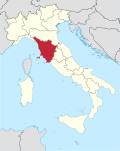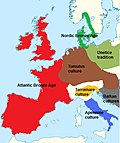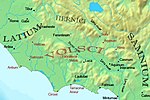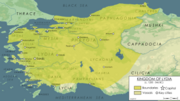The Villanovan culture (c. 900–700 BC), regarded as the earliest phase of the Etruscan civilization, was the earliest Iron Age culture of Italy. It directly...
18 KB (1,531 words) - 01:20, 9 October 2024
The Proto-Villanovan culture was a late Bronze Age culture that appeared in Italy in the first half of the 12th century BC and lasted until the 10th century...
6 KB (609 words) - 19:35, 17 October 2024
of the Roman Kingdom. Latial culture is identified by their hut-shaped burial urns. Urns of the Proto-Villanovan culture are plain and biconical, and...
12 KB (1,474 words) - 20:57, 2 July 2024
Etruscan civilization (redirect from Etruscan culture)
earliest evidence of a culture that is identifiably Etruscan dates from about 900 BC. This is the period of the Iron Age Villanovan culture, considered to be...
108 KB (11,981 words) - 00:59, 14 October 2024
Tuscany (category Villanovan culture)
peoples of the so-called Proto-Villanovan culture (c. 1100 – c. 900 BC) part of the central European Urnfield culture system. Following this, at the beginning...
57 KB (5,570 words) - 01:28, 3 September 2024
Prehistoric Italy (section Proto-Villanovan culture)
in the Proto-Villanovan culture. Pianello di Genga is an exception to the small cemeteries characterized for the Protov-Villanovan culture. More than 500...
34 KB (3,967 words) - 00:11, 26 September 2024
peoples of the so-called of the Proto-Villanovan culture (c. 1100-900 BC) part of the central European Urnfield culture system. Following this, at the beginning...
19 KB (2,290 words) - 04:53, 11 April 2024
Sorano (category Villanovan culture)
tuff stone over the Lente River. Sorano was probably inhabited by Villanovan culture, but the first historical mentions are relative to the 3rd century...
6 KB (580 words) - 12:37, 6 October 2024
Italic peoples (redirect from Italic culture)
collapse. The Proto-Villanovan culture dominated the peninsula and replaced the preceding Apennine culture. The Proto-Villanovans practiced cremation...
25 KB (2,732 words) - 21:47, 26 September 2024
hypotheses. The first is the autochthonous development in situ out of the Villanovan culture, as claimed by the Greek historian Dionysius of Halicarnassus who...
82 KB (10,476 words) - 13:53, 17 September 2024
peninsula by the later Proto-Villanovan culture (1200–900 BC), and perhaps by the contemporary but more northerly Terramare culture (1700–1150 BC). Some of...
10 KB (1,174 words) - 08:41, 18 March 2024
Terramare culture was a dominant component of the Proto-Villanovan culture—especially in its northern and Campanian phases and the Terramare culture has been...
15 KB (1,551 words) - 12:22, 21 October 2023
Latins (Italic tribe) (category Latial culture)
(1200–900 BC). The material culture of the Latins, known as the Latial culture, was a distinctive subset of the proto-Villanovan culture that appeared in parts...
62 KB (7,878 words) - 09:09, 12 September 2024
first attestations of an Etruscan religion can be traced back to the Villanovan culture. Greek traders brought their religion and hero figures with them to...
29 KB (3,288 words) - 16:00, 15 October 2024
c. 1100 BC—Late Minoan culture ends. c. 1100 BC—Greek Dark Ages begin. c. 1100 BC—Beginning of the proto-Villanovan culture in northern Italy. c. 1100...
2 KB (169 words) - 17:46, 18 July 2024
Etruria (category Villanovan culture)
identified as Etruscans. Their complex culture centered on numerous city-states that arose during the Villanovan period in the ninth century BC, and they...
11 KB (967 words) - 12:30, 12 October 2024
Central Europe the Urnfield culture had already given way to the Hallstatt culture. In north Italy the Villanovan culture is regarded as the start of...
32 KB (4,196 words) - 12:54, 8 July 2024
the Lusatian culture is found. In Italy the late Bronze Age Canegrate and Proto-Villanovan cultures and the early Iron Age Villanovan culture show similarities...
104 KB (11,112 words) - 21:57, 2 October 2024
Iron Age: either by autochthonous development in situ out of the Villanovan culture of Etruria in northern and central Italy, or via an eastern (Anatolian...
20 KB (2,158 words) - 09:05, 12 October 2024
area was home to the Apennine and Proto-Villanovan cultures before the advent of the more regional Latial culture. Archaeological evidence suggests that...
43 KB (5,478 words) - 14:46, 10 October 2024
Culture, India are 2,900 years old: The Archaeological Survey of India (ASI) c. 900 BC — the Villanovan culture emerges in northern Italy (Villanovan...
2 KB (273 words) - 01:13, 6 July 2024
archaeology to explore. The Este culture existed next to the Villanovan Culture in the Bologna area and the Golasecca culture in the western Po Valley. It...
8 KB (889 words) - 14:12, 29 September 2024
Lydia (section Culture and society)
earliest phase, the Villanovan culture, emerged around 900 BC, which itself developed from the previous Proto-Villanovan culture of Italy in the late...
69 KB (7,484 words) - 09:32, 13 October 2024
Tyrrhenians (category Villanovan culture)
12th century BC invasion from the Aegean and Anatolia imposing itself over the Villanovan culture, with some scholars claiming a relationship or at least evidence of...
12 KB (1,437 words) - 01:25, 9 October 2024
Women in Etruscan society (section Villanovan period)
or neither. Therefore, the original belief that Villanovan Etruscan women were weavers while Villanovan Etruscan men were warriors may not be entirely...
22 KB (2,487 words) - 22:01, 12 October 2024
Fermo (category Villanovan culture)
funerary remains from the 9th–8th centuries BC, belonging to the Villanovan culture or the proto-Etruscan civilization. The ancient Firmum Picenum was...
12 KB (1,459 words) - 15:11, 5 October 2024
Volterra (category Villanovan culture)
region of Italy. The town was a Bronze Age settlement of the Proto-Villanovan culture, and an important Etruscan center (Velàthre, Velathri or Felathri...
45 KB (4,952 words) - 00:38, 5 October 2024
Populonia (category Villanovan culture)
material of the Villanovan culture, which was Iron Age and began about 900 BC. Except for some cities that probably began in the Proto-Villanovan, 900 is the...
20 KB (2,624 words) - 17:58, 13 August 2024
Pontecagnano Faiano (category Villanovan culture)
necropolises. In the 9th-8th centuries BC remains belonging to the Villanovan Culture, predecessor to the Etruscans, have been found. The Etruscan center...
4 KB (367 words) - 21:56, 20 August 2024
The Bell Beaker culture, also known as the Bell Beaker complex or Bell Beaker phenomenon, is an archaeological culture named after the inverted-bell beaker...
165 KB (19,232 words) - 21:16, 17 October 2024






















